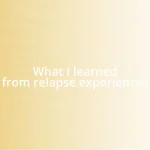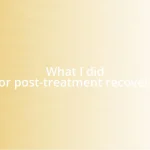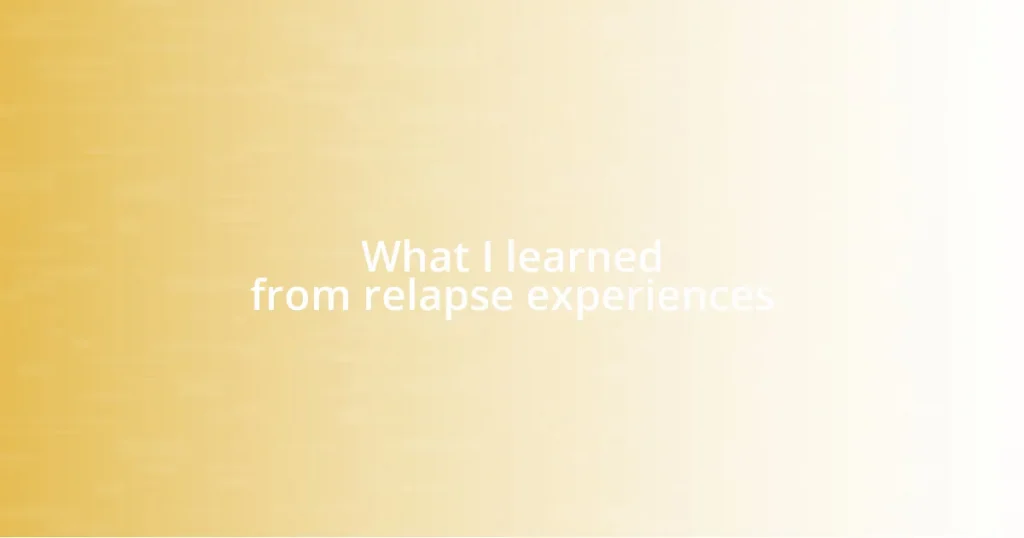Key takeaways:
- Delirium has a sudden onset and fluctuating symptoms, often triggered by medication, infections, or environmental changes.
- Recognizing early symptoms, such as confusion and memory problems, is crucial for timely intervention and better patient support.
- Common causes include infections, environmental changes, and medication adjustments, highlighting the need for careful monitoring.
- Effective treatment and prevention strategies involve creating calming environments, promoting mobility, and educating caregivers and families.

Understanding delirium overview
Delirium can feel like a waking nightmare, where reality shifts and thoughts jumble. I remember a night shift when a normally lucid patient became agitated and confused, muttering about his childhood home. It was a stark reminder of how quickly our perception can fracture, often linked to underlying health issues or environmental changes.
The essence of delirium lies in its sudden onset and fluctuating course, creating an emotional chaos not just for the individual, but for their loved ones as well. Have you ever witnessed someone you care about lose their sense of self, even if just for a moment? That disconnection can be deeply troubling, and it ultimately leads us to ask: what triggers this bewildering state?
Understanding delirium means peeling back layers of complexity, often revealing a cocktail of factors. For many, it’s tied to medication side effects, infections, or even metabolic imbalances. I’ve found that recognizing these causes not only helps in management but also brings a sense of relief to families who may feel helpless watching a loved one in distress.

Recognizing symptoms of delirium
Recognizing the symptoms of delirium can be challenging, especially in the midst of an emotional storm. I recall a poignant moment when my grandmother, typically sharp and witty, suddenly couldn’t remember her grandchildren’s names. That bewildering look in her eyes, as she grappled with her own mind, highlighted how quickly delirium can set in. It’s crucial to pay attention to these signs, which can often come on suddenly and vary throughout the day.
Here are some typical symptoms to watch for:
- Confusion about time and place
- Difficulty focusing or staying on topic
- Memory problems, such as not knowing who family members are
- Rapid changes in emotion, from calm to agitated
- Disrupted sleep patterns and unusual behaviors
- Hallucinations or seeing things that aren’t there
When you’re witnessing these changes, it’s like watching someone drift away, and I often feel a sense of urgency to understand and help them navigate through this fog. Recognizing these symptoms early can be vital for caregivers, enabling us to provide better support and seek appropriate medical intervention.

Exploring common causes of delirium
Understanding the common causes of delirium is crucial for both caregivers and healthcare professionals alike. I’ve seen how a simple urinary tract infection in an elderly patient can trigger a rapid onset of confusion and disorientation. It’s astounding how such a commonplace issue can escalate into something so profound, reminding us that even mild ailments require our serious attention as we navigate the complexities of our patients’ health.
Another aspect I’ve come to appreciate is how environmental changes can contribute significantly to delirium. For instance, I remember a man who was moved from his familiar hospital room to a shared ward. The shift in surroundings sparked a cascade of anxiety and confusion. It’s as if our brains are delicate instruments, finely tuned to the environment around us—altering that environment, even slightly, can disrupt the delicate balance of mental clarity.
Lastly, medications can also play a significant role in the onset of delirium. In my experience, I’ve observed that a shift in a patient’s medication regimen can lead to unexpected cognitive changes. I once witnessed a colleague rush to recalibrate a prescription after a patient began exhibiting signs of delirium. It’s a reminder that while medications are critical in treatment, they must be prescribed and monitored with the utmost care.
| Common Causes of Delirium | Description |
|---|---|
| Infections | Can trigger confusion and cognitive changes, particularly in the elderly. |
| Environmental Changes | Shifts in surroundings can lead to anxiety and disorientation. |
| Medication Changes | Adjustments can affect cognition, necessitating careful monitoring. |

Identifying risk factors for delirium
Identifying risk factors for delirium can feel like piecing together a complex puzzle, but understanding these elements is vital. From my experience, advancing age is one of the most significant indicators. I remember caring for an elderly gentleman whose mental sharpness faded just after he turned 80. It made me realize how age-related changes in the brain can heighten sensitivity to delirium, making preventative measures all the more crucial.
Another risk factor that often stands out to me is the presence of chronic health conditions. I once worked with a hospitalized patient who had multiple issues, including diabetes and kidney disease. When he developed a secondary infection, it seemed to tip the scales, plunging him into confusion. This incident sparked a realization for me: when multiple health challenges exist, the body’s resilience is compromised, increasing the likelihood of delirium.
Let’s not forget about the social and emotional context, either. Isolation can be a silent contributor. I vividly recall a woman who, after losing her husband, hadn’t seen anyone in weeks. When she finally came to the hospital for treatment of dehydration, the disconnect between her emotional state and her need for social interaction seemed profound. It made me ponder—could a little emotional support have changed her mental clarity? Understanding these risk factors isn’t just about the medical aspects; it’s about seeing the whole person and recognizing the complex interplay of health and emotional well-being.

Evaluating diagnostic methods for delirium
Evaluating the diagnostic methods for delirium is a critical step in ensuring proper care. In my experience, the confusion often arises because symptoms can be subtle and can easily be mistaken for other conditions. I recall a case where a patient displayed signs of confusion, but it took a thorough assessment—including family input and understanding their typical cognitive baseline—to finally pinpoint delirium rather than a simple age-related memory loss.
I’ve found that standardized screening tools, such as the Confusion Assessment Method (CAM), can be highly effective in clinical settings. When I first learned to use CAM, it felt like a lightbulb moment. The structured approach helped me quickly assess the presence of delirium, paving the way for interventions that could improve patient outcomes. Have you ever felt the relief that comes from having a clear diagnostic tool in hand? It’s almost like having a reliable compass in a dense fog.
However, I also believe that the diagnostic process extends far beyond checklists and tools. My interactions with patients and their families often provide invaluable context. For instance, there was an instance where a patient’s spouse revealed changes in behavior that had gone unnoticed during clinical assessments. This experience reinforced for me the importance of a holistic approach—involving family dynamics and personal history is just as crucial as any clinical tool. Don’t you think that a blend of clinical assessment and personal narratives can lead us to more accurate diagnoses?

Implementing effective treatment for delirium
Implementing effective treatment for delirium requires a multifaceted approach tailored to the individual’s unique circumstances. I remember working with a patient who was experiencing severe agitation due to delirium. We introduced a calm, structured environment along with regular reassurance from staff, and it transformed his experience. Isn’t it fascinating how something as simple as a soothing atmosphere can significantly impact a patient’s mental clarity?
Medication can play a supporting role, but I’ve learned to tread carefully. During my time in the hospital, I observed a colleague prescribe antipsychotics to help manage a patient’s restlessness. While the intent was good, it reminded me that this is not always the ideal first choice. As we navigated the complexities of medication management, I realized that sometimes non-pharmacological interventions—such as engaging family members and encouraging familiar routines—can yield more beneficial results. Why do we often overlook the power of human connection in these scenarios?
Monitoring the progress of treatment is just as crucial as the interventions themselves. In my own experience, I saw a patient improve notably after we applied a systematic approach, involving daily assessments that guided our adjustments. I often ask myself: how can we continue to refine our strategies to ensure lasting recovery from delirium? This reflective practice not only enhances our understanding but also advocates for an ongoing dialogue between healthcare providers, patients, and families, all aiming for the most effective care possible.

Developing prevention strategies for delirium
Developing prevention strategies for delirium involves understanding the various risk factors that can lead to its onset. I vividly recall a situation where I assisted in a hospital initiative aimed at reducing delirium in elderly patients post-surgery. We implemented a simple yet effective strategy: encouraging mobility as soon as possible. The visible difference in our patients’ alertness and overall recovery was striking. Have you ever witnessed the power of movement to spark clarity?
Another strategy I found beneficial is optimizing the patient’s environment. There was a time when I helped set up a nursing unit designed to minimize noise and confusion. We filled the common areas with familiar decorations and soft lighting, creating a space that felt more like home. The feedback from both patients and their families was overwhelmingly positive, reinforcing my belief that a calming atmosphere can significantly mitigate the risk of delirium. It raises the question: why don’t we prioritize creating these comforting spaces more often?
Lastly, I believe an essential aspect of prevention lies in education. I remember hosting workshops for nursing staff about recognizing early signs of delirium. During these sessions, I shared personal stories of cases where early intervention made a world of difference. It amazed me how empowered the staff felt after gaining new insights and strategies to support their patients effectively. Isn’t it incredible how knowledge can transform our approach to care and prevention?















